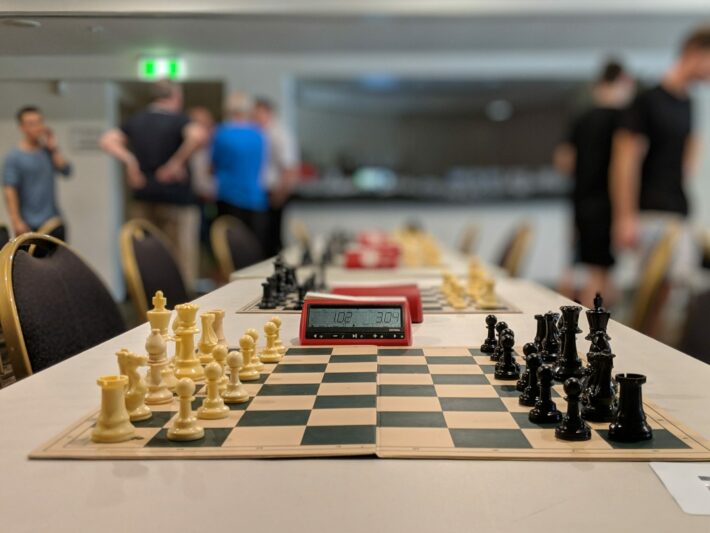Are you ready to conquer the chessboard and outwit your opponents? In the intriguing realm of chess, one of the most formidable defensive openings you’ll encounter is the French Defense.
But fear not, for we’re here to equip you with the knowledge and strategies you need to confidently face this challenging defense. Get ready to elevate your game and discover the secrets to triumphing over the French Defense in chess.
Why is the French Defense a popular choice among chess players?
The French Defense has captured the hearts of chess players around the world for its intriguing nature and strategic depth. With its solid pawn structure and potential for counterplay, it offers a unique challenge that attracts both beginners and seasoned players alike.
Its reputation as a reliable and resilient defense makes it a popular choice for those seeking to test their skills and outmaneuver their opponents. So, if you’re looking for an exciting and dynamic opening to add to your repertoire, the French Defense is definitely worth exploring.
What are the key characteristics of the French Defense opening?
The French Defense boasts several key characteristics that set it apart from other chess openings. One of its defining features is the central pawn structure, with the e6 pawn acting as the backbone of the defense.
This structure creates a solid foundation while also limiting the opponent’s central control. Another characteristic is the emphasis on counterattacking and seizing the initiative.
By inviting the opponent to advance their pawns and committing to defending them, the French Defense allows for tactical opportunities and strategic counterplay. Understanding these key characteristics is crucial for navigating the complexities of the French Defense and utilizing its strengths to your advantage.
How can understanding the French Defense benefit your overall chess skills?

Exploring and understanding the French Defense can significantly benefit your overall chess skills. This opening offers a wealth of strategic and tactical ideas that can be applied to various other positions and games.
By studying the French Defense, you develop a deeper understanding of pawn structures, piece coordination, and positional concepts such as central control and pawn breaks.
Additionally, analyzing the French Defense helps enhance your ability to evaluate imbalances and weaknesses, as well as recognize potential tactical opportunities. The insights gained from studying this opening will undoubtedly enrich your chess knowledge and sharpen your gameplay across the board.
What are the main ideas and principles behind the French Defense?
The French Defense is built upon several main ideas and principles that guide its strategic approach. One of the core concepts is establishing a sturdy pawn chain, typically with pawns on d4 and e6, which aims to control the center and limit the opponent’s possibilities.
Another principle involves putting pressure on the opponent’s central pawns, especially the d4 pawn, to disrupt their pawn structure and create imbalances.
Additionally, the French Defense emphasizes the development of minor pieces and the importance of piece activity and coordination. By understanding and applying these main ideas and principles, you can navigate the French Defense with confidence and set yourself up for success.
What are the common variations within the French Defense and their unique challenges?
The French Defense encompasses a range of common variations, each with its unique challenges and strategic nuances. The Classical Variation focuses on solid pawn structures and strategic maneuvering, often leading to a closed and strategic battle.
The Winawer Variation, on the other hand, introduces sharper and more tactical positions, with Black willingly accepting pawn weaknesses in exchange for active piece play. The Tarrasch Variation emphasizes piece development and control of key central squares, while the Advance Variation involves an early pawn push to challenge Black’s central control.
Each variation within the French Defense presents distinct challenges, demanding different strategic approaches and tactical awareness. Familiarizing yourself with these variations and their intricacies will expand your understanding of the French Defense and enable you to adapt your gameplay accordingly.
Which piece setups are effective when playing against the French Defense?
When facing the French Defense, certain piece setups can prove highly effective in countering your opponent’s strategies. One common approach is to develop your pieces harmoniously, aiming for a solid and flexible formation.
Placing your pawns on e5 and d4 can provide strong central control and restrict the opponent’s pawn breaks. Active piece development, particularly the development of the knight to f3 and bishop to d3, helps establish a solid presence in the center.
Additionally, maintaining coordination between your pieces and preparing for potential pawn breaks, such as f2-f4 or c2-c4, can give you the initiative and disrupt the opponent’s position. By implementing these piece setups when playing against the French Defense, you can set yourself up for a dynamic and advantageous game.
How can you exploit weaknesses in the French Defense to gain an advantage?

Exploiting weaknesses in the French Defense can provide you with a crucial advantage on the chessboard. One key aspect to consider is targeting weak pawns, such as the backward pawn on d6 or the isolated pawns resulting from pawn exchanges.
By focusing your attacks on these vulnerable pawns, you can undermine your opponent’s pawn structure and create weaknesses that can be exploited later in the game. Furthermore, capitalizing on poorly coordinated pieces, especially if the opponent’s pieces struggle to find optimal squares, can give you an edge in piece activity and control of key positions.
Additionally, paying attention to the opponent’s king safety, especially if they have weakened pawn cover, can allow you to launch powerful attacks and gain a decisive advantage.
What are the crucial positional concepts to keep in mind when facing the French Defense?
When facing the French Defense, several crucial positional concepts should guide your decision-making. Firstly, understanding and utilizing pawn breaks is essential. Timing well-executed pawn breaks, such as f2-f4 or c2-c4, can disrupt the opponent’s pawn structure and create open lines for your pieces.
Additionally, maintaining central control is key, as the French Defense often revolves around the struggle for central dominance. Ensuring your pieces occupy key central squares and controlling the critical e5 and d4 squares can limit your opponent’s options and create opportunities for your own attacks.
Finally, maintaining piece coordination and harmonious development is vital. Coordinated pieces work together effectively and enable you to exploit tactical opportunities.
How can you disrupt your opponent’s plans within the French Defense?
One effective way to disrupt your opponent’s plans is by challenging their pawn structure. Look for opportunities to undermine their pawn chain, especially targeting weak pawns or creating pawn breaks.
By creating imbalances and weakening their position, you can throw them off balance and force them to react defensively, limiting their strategic options. Additionally, keeping your pieces active and maintaining pressure on their position can disrupt their plans and make it more difficult for them to execute their intended strategies.
What are the best attacking strategies against the French Defense?
When launching attacks against the French Defense, it’s crucial to capitalize on the weaknesses inherent in this opening. Exploit the weakened pawn structure, especially focusing on isolated or backward pawns.
By coordinating your pieces effectively and applying pressure on these vulnerable points, you can create tactical opportunities and launch powerful attacks.
Additionally, seizing control of key central squares and utilizing open lines can allow your pieces to infiltrate the opponent’s position, putting them under pressure and forcing them into defensive positions.
How do you navigate the pawn structure in the French Defense for optimal results?
Navigating the pawn structure in the French Defense requires a careful balance of strategic understanding and tactical awareness. One key aspect is understanding when to maintain the tension in the center or when to release it with well-timed pawn breaks.
By evaluating the advantages and disadvantages of each pawn structure, you can determine the most favorable course of action.
Additionally, paying attention to pawn breaks such as f2-f4 or c2-c4 can disrupt the opponent’s pawn structure and create open lines for your pieces.
What are the common mistakes to avoid when playing against the French Defense?

When facing the French Defense, it’s important to avoid falling into common pitfalls. One common mistake is underestimating the importance of central control.
Failing to contest the critical central squares can allow your opponent to establish a solid position and execute their plans unhindered. Additionally, neglecting piece coordination and development can result in passive or poorly placed pieces, limiting your attacking potential.
It’s also essential to avoid overly simplifying the position too early, as the French Defense often offers strategic complexities that can be exploited with proper maneuvering.
How can you maintain flexibility and adaptability in your gameplay against the French Defense?
Flexibility and adaptability are key attributes when facing the French Defense. One way to maintain flexibility is by choosing flexible move orders that allow you to adjust your plans based on your opponent’s responses.
By keeping multiple strategic options open, you can adapt your gameplay to exploit any weaknesses or opportunities that arise.
Additionally, remaining open-minded during the game and being willing to reassess and readjust your plans in response to your opponent’s moves can enhance your adaptability. This flexibility allows you to capitalize on unexpected positions or tactical opportunities, giving you an edge in the game.
What are the recommended resources and references to enhance your knowledge of the French Defense?
To enhance your knowledge of the French Defense, there are various resources and references available. Books and publications by renowned chess authors such as Grandmasters Anatoly Karpov, Viktor Korchnoi, and Lev Psakhis offer in-depth analysis and strategic insights into the French Defense.
Online platforms like chess databases and video tutorials from experienced players can provide practical examples and guidance. Additionally, studying games played by top-level chess players who specialize in the French Defense can offer valuable lessons and inspire new ideas.
How can you use psychological tactics to gain an edge when facing the French Defense?
| Aspect | Advantages | Disadvantages |
|---|---|---|
| Pawn Structure | Offers potential weaknesses to exploit | Can be solid and resilient |
| Strategic Complexity | Allows for dynamic and tactical play | Requires careful maneuvering and planning |
| Counterattacking Opportunities | Invites opponent to overextend and create vulnerabilities | Requires precise timing and accurate calculation |
| Piece Coordination | Offers chances for active piece play | Can be challenging to achieve optimal coordination |
| Psychological Impact | Can unsettle opponents and create psychological pressure | Requires confidence and composure to handle |
Psychological tactics can play a significant role in gaining an edge when facing the French Defense. One strategy is to surprise your opponent with uncommon or lesser-known variations within the French Defense, catching them off guard and unsettling their preparation.
Creating a dynamic and unpredictable playing style can also put psychological pressure on your opponent, making it more challenging for them to find their comfort zone.
Additionally, maintaining a confident and composed demeanor can project strength and unsettle your opponent, potentially leading them to make mistakes or play overly defensively. By leveraging psychological tactics alongside your chess skills, you can gain a psychological edge and tilt the balance in your favor when facing the French Defense.
Final thoughts
In conclusion, the French Defense is a captivating and strategic opening that has captivated chess players worldwide. Its popularity stems from its solid pawn structure, potential for counterplay, and rich complexity.
Understanding the key characteristics, ideas, and variations within the French Defense empowers players to navigate its challenges and exploit weaknesses to their advantage. By maintaining flexible and adaptable gameplay, avoiding common mistakes, and employing psychological tactics, players can gain an edge against opponents employing the French Defense.
With a wealth of resources available to enhance knowledge and strategic understanding, the French Defense offers endless possibilities for growth and enjoyment in the game of chess. So embrace the French Defense, and may your chess journey be filled with exciting battles and triumphant victories.




